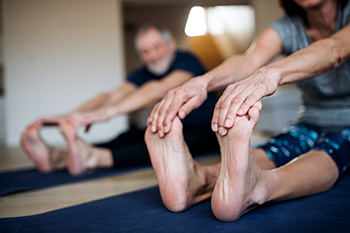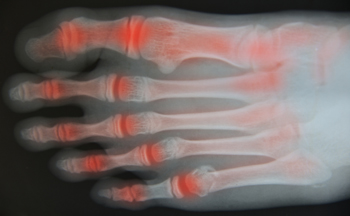April 2023
Relief Options for Bunions

A small hardened lump on the outside of the big toe may indicate a bunion has formed. It can grow in size if treatment is not sought, and can cause the other toes to shift toward each other. Bunions form as a result of genetic factors, or they may happen from wearing shoes that do not have adequate room for the toes to move in freely. It is considered to be a deformity and may be painful, often causing difficulty in walking. Some patients notice there is redness and swelling surrounding the bunion, and it may reduce range of motion in the big toe. Relief may be found when the correct size shoes are worn, with enough room for the toes to move in. Additionally, orthotics may be worn which may improve comfort and foot alignment. Corns may form on top of the bunion, where it rubs against the shoe, and wearing a protective pad over the bunion may temporarily provide relief. If you have a bunion, it is suggested that you consult with a podiatrist who can offer you treatment solutions, which may include minor surgery for permanent removal.
If you are suffering from bunions, contact Dr. Eugenio Rivera of Calo Foot & Ankle Specialists. Our doctor can provide the care you need to keep you pain-free and on your feet.
What Is a Bunion?
A bunion is formed of swollen tissue or an enlargement of boney growth, usually located at the base joint of the toe that connects to the foot. The swelling occurs due to the bones in the big toe shifting inward, which impacts the other toes of the foot. This causes the area around the base of the big toe to become inflamed and painful.
Why Do Bunions Form?
Genetics – Susceptibility to bunions are often hereditary
Stress on the feet – Poorly fitted and uncomfortable footwear that places stress on feet, such as heels, can worsen existing bunions
How Are Bunions Diagnosed?
Doctors often perform two tests – blood tests and x-rays – when trying to diagnose bunions, especially in the early stages of development. Blood tests help determine if the foot pain is being caused by something else, such as arthritis, while x-rays provide a clear picture of your bone structure to your doctor.
How Are Bunions Treated?
- Refrain from wearing heels or similar shoes that cause discomfort
- Select wider shoes that can provide more comfort and reduce pain
- Anti-inflammatory and pain management drugs
- Orthotics or foot inserts
- Surgery
If you have any questions, please feel free to contact our office located in Bellaire, TX . We offer the newest diagnostic and treatment technologies for all your foot care needs.
Stretches for Runners

Research has shown many people who enjoy running lack the appropriate time to properly stretch. The sport of running can range from jogging 15 minutes per day to preparing for a marathon. It is beneficial to learn how to prevent running injuries, and this generally begins by warming up and cooling down before and after running. Effective stretches for runners can include the hip flexor and quad stretch. This is done by kneeling on one leg, reaching back, and bringing the bent leg as close as possible to the buttocks. The hamstrings can easily get hurt if they are not stretched properly. Lying on the floor, raising one leg up, and using a band that is wrapped around that leg while pulling it forward is considered to be a good hamstring stretch. If you would like to learn about additional stretches that can help to prevent running injuries, it is suggested that you consult with a podiatrist who can help you to achieve your running goals without injury.
Exercising your feet regularly with the proper foot wear is a great way to prevent injuries. If you have any concerns about your feet, contact Dr. Eugenio Rivera of Calo Foot & Ankle Specialists. Our doctor will treat your foot and ankle needs.
How to Prevent Running Injuries
Many common running injuries are caused by overuse and overtraining. When the back of the kneecap starts wearing out and starts causing pain in your knee, this is commonly referred to as runner’s knee. Runner’s knee is a decrease in strength in your quadriceps and can occur if you’re not wearing properly fitted or supporting shoes. To prevent runner’s knee, focusing on hip strengthening is a good idea, as well as strengthening your quads to keep the kneecaps aligned.
What Are Some Causes of Running Injuries?
- One cause of a common running injury is called iliotibial band syndrome.
- Plantar fasciitis is also another common injury.
- Stress fractures can occur from overtraining, lack of calcium, or even your running style.
Best Ways to Prevent Running Injuries
- Wear footwear that fits properly and suits your running needs.
- Running shoes are the only protective gear that runners have to safeguard them from injury.
- Make a training schedule. Adding strengthening exercises as well as regular stretching can help keep you strong and limber and can lessen the possibility of injuries.
- Stretching keeps muscles limber; this will help you gain better flexibility.
If you have any questions please feel free to contact our office located in Bellaire, TX . We offer the newest diagnostic and treatment technologies for all your foot and ankle needs.
Facts About Rheumatoid Arthritis

Rheumatoid arthritis, or RA, is an auto-immune disease that causes pain, swelling, and stiffness in the joints. The feet, which contain multiple joints, are often affected by this inflammatory condition. The immune system, instead of protecting the joints, sends antibodies into the lining of the joints causing the tissue surrounding the joint to become inflamed. This results in damage to the bones, tendons, ligaments, and cartilage. Many people are affected by RA, but most develop it between the ages of 40 and 50. Women are three times more likely to have rheumatoid arthritis than men, largely due to hormonal differences. Also, it affects many people who smoke or have a genetic tendency toward the disease. RA causes throbbing and aching pain, and may induce fatigue and fever along with a loss of appetite. Rheumatoid arthritis is not curable, but measures may be taken to reduce the symptoms. If you think you may have RA that is affecting your feet, it is suggested that you consult a podiatrist for treatment options.
Because RA affects more than just your joints, including the joints in your feet and ankles, it is important to seek early diagnosis from your podiatrist if you feel like the pain in your feet might be caused by RA. For more information, contact Dr. Eugenio Rivera of Calo Foot & Ankle Specialists. Our doctor will assist you with all of your podiatric concerns.
What Is Rheumatoid Arthritis?
Rheumatoid Arthritis (RA) is an autoimmune disorder in which the body’s own immune system attacks the membranes surrounding the joints. Inflammation of the lining and eventually the destruction of the joint’s cartilage and bone occur, causing severe pain and immobility.
Rheumatoid Arthritis of the Feet
Although RA usually attacks multiple bones and joints throughout the entire body, almost 90 percent of cases result in pain in the foot or ankle area.
Symptoms
- Swelling and pain in the feet
- Stiffness in the feet
- Pain on the ball or sole of feet
- Joint shift and deformation
Diagnosis
Quick diagnosis of RA in the feet is important so that the podiatrist can treat the area effectively. Your doctor will ask you about your medical history, occupation, and lifestyle to determine the origin of the condition. Rheumatoid Factor tests help to determine if someone is affected by the disease.
If you have any questions please feel free to contact our office located in Bellaire, TX . We offer the newest diagnostic and treatment technologies for all your foot and ankle needs.
Wounds That Don't Heal Need to Be Checked
Diabetics May Be at Risk for Charcot Foot

Many diabetics suffer from a related condition known as Charcot foot. It is caused by peripheral neuropathy, which is nerve damage and a loss of sensation in the lower legs and feet. Diabetics with Charcot foot may notice redness, warmth, and swelling of the feet, the condition also weakens the bones, soft tissues, and joints of the foot. As the disease progresses it may lead to fractures and dislocation of the ankle bones. Charcot foot can be detected through a physical examination, X-rays, and blood tests. The condition generally affects only one foot. Taking the weight off the affected foot is paramount in helping to keep symptoms at bay. The bones in the foot can easily collapse and if ignored can produce even more serious problems. In some cases, patients are directed to wear a special boot or cast to protect the foot. Orthotic inserts in shoes are often helpful in providing the needed cushioning. If you are experiencing symptoms of Charcot foot, it is suggested that you consult a podiatrist as soon as possible for an exam and diagnosis.
Neuropathy
Neuropathy can be a potentially serious condition, especially if it is left undiagnosed. If you have any concerns that you may be experiencing nerve loss in your feet, consult with Dr. Eugenio Rivera from Calo Foot & Ankle Specialists. Our doctor will assess your condition and provide you with quality foot and ankle treatment for neuropathy.
What Is Neuropathy?
Neuropathy is a condition that leads to damage to the nerves in the body. Peripheral neuropathy, or neuropathy that affects your peripheral nervous system, usually occurs in the feet. Neuropathy can be triggered by a number of different causes. Such causes include diabetes, infections, cancers, disorders, and toxic substances.
Symptoms of Neuropathy Include:
- Numbness
- Sensation loss
- Prickling and tingling sensations
- Throbbing, freezing, burning pains
- Muscle weakness
Those with diabetes are at serious risk due to being unable to feel an ulcer on their feet. Diabetics usually also suffer from poor blood circulation. This can lead to the wound not healing, infections occurring, and the limb may have to be amputated.
Treatment
To treat neuropathy in the foot, podiatrists will first diagnose the cause of the neuropathy. Figuring out the underlying cause of the neuropathy will allow the podiatrist to prescribe the best treatment, whether it be caused by diabetes, toxic substance exposure, infection, etc. If the nerve has not died, then it’s possible that sensation may be able to return to the foot.
Pain medication may be issued for pain. Electrical nerve stimulation can be used to stimulate nerves. If the neuropathy is caused from pressure on the nerves, then surgery may be necessary.
If you have any questions, please feel free to contact our office located in Bellaire, TX . We offer the newest diagnostic and treatment technologies for all your foot care needs.










